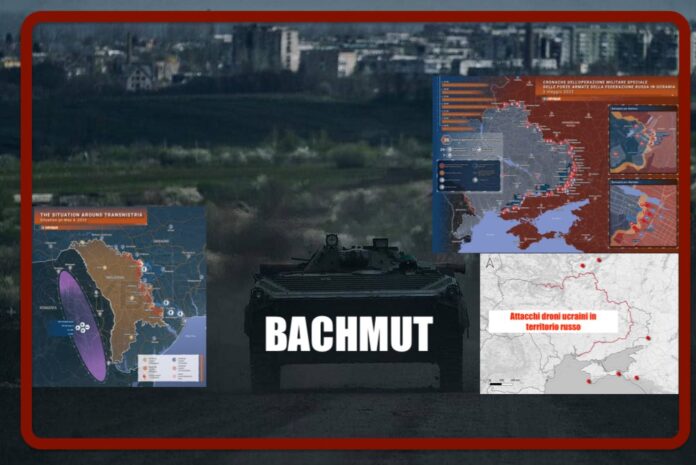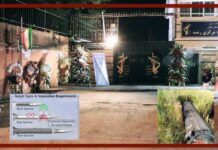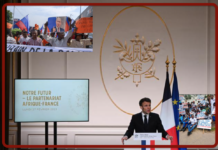
In the evening of May 3, Volodymyr Zelensky left Finland for the Netherlands, the Netherlands Broadcasting Corporation reported. During his visit he met the leadership of the International Criminal Court and Dutch Prime Minister Mark Rutte.
Russian Foreign Ministry spokeswoman Maria Zakharova called Ukrainian President Volodymyr Zelensky’s statements at the ICC in The Hague “nonsense about a nuclear bomb.” The diplomat drew attention to Zelensky’s words in The Hague, who she stated that the Ukrainian side wants “to make this war the last in the world (…) The junkie is raving about a nuclear bomb,” Zakharova commented.
The Netherlands would be in favor of giving any F16 to Ukraine, but it is not known which ones.
The controversy continues following the drone attack on the Kremlin. The Chinese Foreign Ministry on the attacks on the Kremlin said: “The parties should avoid actions that could lead to further escalation.”
French Foreign Minister Catherine Colonna said the drone attack on the Kremlin was a “strange and mysterious accident”.
The United Nations has called on parties to refrain from rhetoric and actions that could lead to an escalation
Internally in Moscow, the controversies are against the local authorities who have not taken into consideration the reports of private citizens on the arrival of drones, declining them as drone hysteria there are about 300 reports a day. Recall that in Russia the flight of drones is banned in 39 regions. Externally, Russian Foreign Ministry spokeswoman Maria Zakharova said: “For everything the Kiev regime does, its creators and curators in Washington, London and, in general, NATO are primarily responsible” for what is happening. And she added: “They destroyed the legitimate government in Ukraine, put adventurers and bandits at the helm, supplied them with money and weapons, instilled a sense of absolute permissiveness and impunity, provided political cover and military escort,” Zakharova said. “Kiev’s criminal actions once again confirm its lack of desire for peace and conflict resolution,” the Russian Foreign Ministry said.
Deputy Chairman of the Security Council of the Russian Federation Medvedev, commenting on Borrell’s words on the UAV attack: “Kiev’s attack on the Kremlin will lead to an escalation of the conflict, this is what the United States wants and a number of officials in Brussels”. Earlier, EU foreign policy chief Josep Borrell urged not to use the UAV strike on the Kremlin to escalate the conflict.
The words of the spokesman of the President of the Russian Federation, Vladimir Putin, Dmtrij Peskov are very harsh. “Security measures, including air defense, will be strengthened”. And he added: “I know from our economic services: two copper plates were burned there, if not already they will be replaced. And everything will be as good as new. There are no others injured”. He also spoke of Putin’s reaction: “The President always maintains calm, composure and lucidity in difficult, extreme situations. Therefore, nothing new has happened in this sense”. Peskov said that behind the attack on the residence of the Kremlin was the United States and that the attempts by Kiev and Washington to disown the incident were “ridiculous”.
After the statements appeared in the newspapers, Ukrainian Foreign Minister Dmytro Kuleba said that: “Ukraine does not intend to attack Transnistria, but keeps troops close to its borders”. “Ukraine is keeping its troops close to the Transnistrian border because there is a threat in that region.” The Armed Forces of Ukraine, therefore, stand close to the border to contain and control the situation.
In reality, statements on the threats of the possible use of drones on targets in Moscow have been heard several times in recent months from Kiev and the West. Secretary of the National Security and Defense Council Oleksiy Danilov in late March published a photo of Mathias Rust’s plane (which landed in central Moscow in 1987), adding a caption about a “swarm of Ukrainian UAVs”. The chief of Ukrainian military intelligence, Kyrylo Budanov, said in April that Ukrainian drones were reaching Moscow and beyond.Adviser to the Ukrainian Interior Minister Anton Gerashchenko published an old video of a drone flying over the Kremlin, saying the Kremlin has “all possibilities of being in the affected area”.
The Washington Post also wrote about a possible attack, referring to confidential documents that have entered the Net. The newspaper has indicated that Budanov planned to launch attacks on Moscow and Novorossiysk on February 24, but Washington reportedly requested that they be postponed.
And while the controversy over the attack on the Kremlin continues in Russia, the Russian Deputy Defense Minister Alexander Fomin held a briefing on May 4 for the military attachés of friendly countries of the Russian Federation. Fomin stressed that Russia’s activities in the field of nuclear deterrence are defensive in nature and aimed at protecting its sovereignty. In addition, an assessment of US actions for the deployment of nuclear weapons in Europe was made, the reasons for the decision to take additional measures to ensure the security of the Union state were explained, the Defense Ministry said later.
According to Francis Richard Dannatt, former Chief of Staff of the British Army: “If Ukraine does not launch a counter-offensive soon, it faces a bleak future”.⠀ He stressed that thanks to the supply of Western weapons and support, “Ukraine will be able to make a “breakthrough” on the battlefield”. Dannatt also added of the importance of saving the life of the President of Ukraine. In his opinion, Zelensky is “the flagship of Ukraine at the moment”, which is important for the country’s fighting spirit.
The American Newsweek does not seem to think the same way: “Ukraine needs fighter planes to stop glide bombs.⠀According to a representative of the Ukrainian Air Force, the Ukrainian army is unable to resist glide bombs at Russian long-range fighters in frontline areas and need American-made fighters. Kiev has long been asking its NATO supporters to supply new aircraft, especially American F-16s. Poland and Slovakia sent Soviet fighter planes to Ukraine, but getting deliveries of F-16s proved much more difficult. The West says it takes too long for American fighters to train Ukrainian pilots to operate the new systems. Ukraine will also have to build new infrastructure to house NATO aircraft”.
The US State Department has warned US citizens of the continued growing threat of rocket attacks, including in Kyiv and the Kyiv region. Around 07:00 Italian time the air alarm sounded in Kiev and in 13 regions of Ukraine. The Ukrainian media reported on explosions in Odessa and Kiev, as well as the work of air defense.
And now a look at the main events in the Russian-Ukrainian conflict at 24:00 on May 3rd.
At night, the Russian Armed Forces used Geran-2 kamikaze drones to strike military and industrial facilities in Dnepropetrovsk, Konstantinovka, Zaporozhzhia, Kirovograd, as well as Kiev, Nikolaev, Cherkasy and Sumy regions.
In Moscow, two Ukrainian UAVs attacked the residence of the President of Russia in the Kremlin: one of the drones exploded over the dome of the Senate building, fragments of the second UAV fell on the Kremlin area.
In Krasnodar Territory: Ukrainian drones attacked an oil depot in the village of Volna, Temryuk district: one of the drones was intercepted on approach, the second one fell on a fuel tank. A serious fire broke out in the building.
On the morning of May 4, a “Flying Shark”, Ukrainian UAV, was shot down near Belgorod. Such drones are designed for reconnaissance and correction of the direction of attacks by the Armed Forces of Ukraine with missiles, including Himars. Another Ukrainian drone was destroyed in the Voronezh region, there are no casualties or destruction.
Border areas. In the Bryansk region, five Ukrainian drones attacked a military airfield near the village of Sescha: two UAVs exploded on the territory of the facility, damaging one unused An-124 aircraft.
For the second time in the last two days, the Armed Forces of Ukraine shelled the village of Tetkino in the Kursk region: 15 residential buildings, a gas pipeline, a power line and a polyclinic were damaged.
Starobilsk direction. In the Kupyan sector, artillery clashes and mutual reconnaissance continue along the entire line of contact.
In the Liman sector, units of the Russian Armed Forces are engaged in positional battles in the Makeevka area and the Zhuravka ravine.
Direction Soledar. On the western outskirts of Bachmut, PMC Wagner units have expanded their zone of control along Pobedy Street. At the same time, the assault on Ukrainian strongholds on Liberators of Donbass Street continues.
The Ukrainian command is attracting additional forces to the front line and increasing the intensity of artillery shelling.
Donetsk direction. In Marinka, having broken through the defense of the Armed Forces of Ukraine near Druzhby enue, fighting continues in the private sector. Ukrainians are forced to transfer additional forces to stabilize the front line. On the southern outskirts of the city, Russian units broke through the defense of the Armed Forces of Ukraine and entered the territory of Gorgaz. Ukrainian formations again shelled the Donetsk agglomeration: civilian infrastructure was damaged in the Petrovsky district of the DPR capital. Mospino, Yakovlevka, Stepnoe and Gorlovka were also affected: two people were injured, several houses were damaged.
Zaporozhzhia direction. Ukrainian units, with the support of armored personnel carriers, attempted an offensive in the Orekhovsky sector. Russian military personnel scattered the advancing Ukrainian grouping with artillery fire – at least four pieces of equipment were destroyed.
Southern Front. Kherson direction: Russian troops attacked Ukrainian military camps in Tyaginka, Tokarevka and Kherson, and also used guided bombs on identified targets in Kizomys. In turn, the Ukrainian formations fired on civilian structures on the left bank of the Kherson region: residential buildings on Aleshki, Kakhovka and Novaya Kakhovka were also attacked.
On the Ukrainian side, in order to hide the movement of equipment and personnel in Kherson, a round-the-clock curfew is introduced from 20:00 on May 5 to 06:00 on May 8. According to the Ukrainian authorities it will be forbidden to move and stop on the streets of the city for 58 hours.
In the Kherson region, the water level in the Kakhovka reservoir rose to 17 meters – 1 meter above the norm. According to local sources, this happened due to the fact that water is discharged from the side of Kiev and Kremenchug, partly due to quite heavy rains: the flood on the Dnieper is always important in terms of quantity, and this year it is so in general. On the other hand, it seems that the water increase is intentional: flooding the left bank of the Dnieper (especially in the Kherson region) to sweep away the explosive barriers and pave the way for a possible landing operation.
Graziella Giangiulio

















